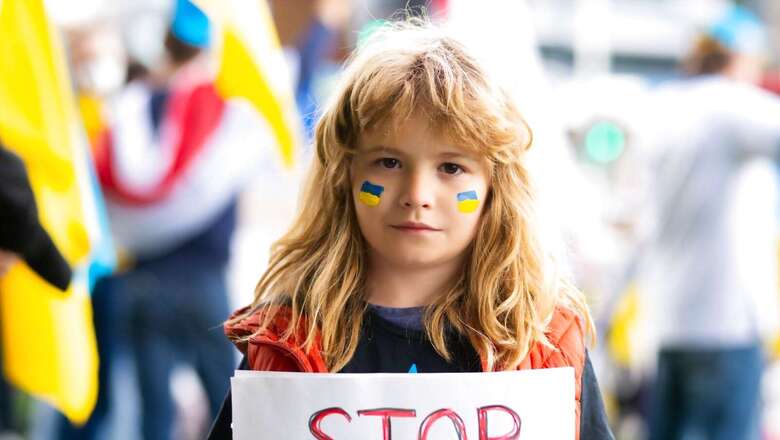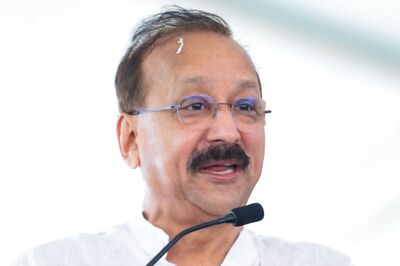
views
When a year ago on Thursday, February 24, 2022, around 5 AM Moscow time, on President Vladimir Putin’s order, the Russian military launched a full-scale war against Ukraine, there was a consensus among the analysts and members of the commentariat- “faced with the Russian blitzkrieg launched on the ground, from the air and from the sea, the largest attack of a state against another state in Europe after the World War II, the minnow Ukraine would capitulate within a week or so.”
It was not to be. The initial decapitation of Kyiv did not materialise despite all going well for Russia that initially looked to be on the brink of success. Backed by Western financial, intelligence and military support, the Ukrainian resolve surprised all and defied all expectations.
And the result was – a soon-to-be vanquished nation, Ukraine showed unfathomable grit, incredible fortitude and extraordinary ability to defend, attack and counterattack, making the country a force to contend with and the country’s President Volodymyr Zelenskyy, a poster boy of resistance and heroism of the 21st century.
It has been a year since and the actualisation of the dream of the Russian President’s victory in the war remains elusive, forcing him to reformulate his strategy to alter the course of this long-term war of attrition, looking for a symbolic victory in the Eastern Ukrainian city of Bakhmut, ahead of the anniversary of the war.
NO VICTOR IN THE WAR
In the past year of the war, that few analysts and experts thought would last a week or mostly a month, and no one could imagine a year, losses to both sides have been staggering. And there is no sight of the end of the war.
In the last 365 days, Russian forces have captured Ukraine cities, Ukraine has recaptured many ceded territories, whole cities have been destroyed in the war, civilians have died in droves, and incalculable war human rights violations have been committed. But no one expected Ukraine troops to fare as well as they have done against the mighty Russians.
After initially fast ceding territories, with a force no one thought Ukraine possessed, it launched successful counter-offensives with tanks, missiles and drones in the East and the South, recapturing Kharkiv, Kherson, Kupiansk and Mariupol and hoping against hope that Ukraine someday will recapture Crimea and Donbas regions. Nonetheless, the territorial loss to Ukraine along with consequential human loss has been immense.
As per an Economist map, at the height of Russia’s success, its troops controlled or were advancing on around 160,000 square kilometres of Ukrainian territory—about 25 percent of the country. That was in March 2022. Since then, the actual area under Russian control has shrunk. As per the British Defence Ministry numbers in January 2023, Ukraine had liberated 54 percent of the territories that Russia had seized since February 24, 2022. And a new analysis by The Guardian shows that Russia now controls 40,000 sq miles of Ukrainian land, entirely in the South and East. This is 17 percent of Ukraine – a country of 230,000 sq miles, or twice the size of Italy. The analysis also shows that Russia still controls a majority of the land in each of the four regions it attempted to annex last year — Luhansk, Kherson, Zaporizhzhia and Donetsk.
The regions where Ukraine forces have succeeded in repelling the Russian military are – Chernihiv, Kyiv, Sumy, Zhytomyr and Mykolaiv – these are the areas where substantial territory was controlled by Russia, at one or another, during the war. The most notable has been the case of Kharkiv, where it is estimated that Russian forces control just 1 percent of the region’s land after successful Ukrainian counterattacks. However, the war remains what it is- a stalemate and the future of Ukraine totally uncertain, despite extraordinary financial, intelligence, logistics and military support of the Western world to it.
HUMAN CATASTROPHE
The war has already turned into a human catastrophe of gigantic proportions for Ukraine citizens. Deploring the human cost of the conflict, United Nations High Commissioner for Human Rights (UNHCHR), Volker Türk, said on February 21, 2023, that every day, violations of international human rights and humanitarian law continue, and “it becomes harder and harder to find a way forward through mounting suffering and destruction, towards peace.”
And the truth beckons, no one knows where this war to nowhere is heading to.
What have been the consequences of the war?
THE COLLATERAL DAMAGE
In the year gone by, the collateral damage of the war has been humungous for Ukraine, Russia and the world at large. The following are the more important ones-
One, A refugee crisis of monumental proportions- The war has led to an unprecedented refugee crisis. As per UNHCHR Operational Data Portal, as on February 15, 2023, a total of 8,075,440 refugees from Ukraine have been recorded across Europe. It is also estimated that another eight million have been internally displaced from their homes within the country. As per Filippo Grandi, who heads the U.N. High Commissioner for Refugees, Russia has driven some 14 million Ukrainians from their homes in “the fastest, largest displacement witnessed in decades,” sparking an increase in the number of refugees and displaced people worldwide to more than 103 million.
This is a humanitarian crisis of monumental proportions.
Two, Large and growing uncertain civilian casualty- With regard to civilian casualty in an armed conflict, it is notoriously difficult to collect and collate the number of dead and injured. This conflict is no exception. Nonetheless, as per the estimates of UN Human Rights data, in the past year, Ukraine has suffered at least 8,000 non-combatant deaths and 13,300 injured, with men accounting for 61.1 percent of the confirmed civilian casualties and women 39.9 percent. Also, at least 487 children were killed and 954 injured.
More recently, Andriy Kostin, Ukraine’s prosecutor general, has blamed Russia for committing more than 68,000 war crimes. His numbers include 9,655 civilians killed and 12,829 wounded and more than 16,000 children forcibly deported to Russia. And the list goes on- 80,000 buildings were badly damaged or destroyed, including 462 hospitals, and critical energy infrastructure was hit by Russian forces 255 times. Apart from war deaths and injuries, there is the collateral psychic crisis due to reported human rights violations including sexual abuse by the Russian forces.
This is only part of the story- true numbers will be substantially higher, once the final picture emerges after the war is long over.
Three, Extreme hardship to hapless citizens- Millions inside Ukraine continue to suffer extreme hardship due to a shortage of daily necessities like food, electricity, and water. As per one estimate by UNCHR, nearly 18 million people are in dire need of humanitarian assistance. This is as bad as it can get.
Four, Ukrainian children biggest casualty of war- Children have paid the biggest price of the war. UNICEF Executive Director, Catherine Russell, puts it squarely- “Children in Ukraine have experienced a year of horror with not a single aspect of their lives spared by the conflict. Millions of them daily go to sleep cold and scared and wake up hoping for an end to this brutal war.” Also, according to UNICEF, the percentage of children living in poverty has almost doubled from 43 percent to 82 percent. The situation is especially acute for millions of children who are currently displaced within Ukraine.
There is another sinister implication of the armed conflict- the deleterious impact on the mental health of the children. As per the UNICEF data, Ukrainian children have already suffered an unfathomable devastating mental health crisis, with an estimated 1.5 million children at risk of depression, anxiety, post-traumatic stress disorder and other mental health issues, with potential long-term effects and implications.
UNICEF says it all, “Children have been killed and injured, and many have lost parents and siblings, their homes, schools, and playgrounds. No child should ever have to bear that kind of suffering.”
Five, Aura of the invincibility of Russian military stands punctured-Before the commencement of the current Russia-Ukraine war, once USSR supremo, Joseph Stalin, said, “History shows that there are no invincible armies and that there never have been.” Putin would have mocked Stalin’s words a year ago, but the dogged Ukraine resistance has proved Stalin right, at least so far as today, with Russia dug deep inside a war where victory is nowhere in sight.
Six, Military of both sides have suffered immensely- At the peak of World War II, on July 3, 1938, in a speech at Kettering, British Prime Minister Neville Chamberlain famously said, “In war, whichever side may call itself the victor, there are no winners, but all are losers.” His statement holds true today, as the biggest war since WWII on European soil rages on the ground, sea and the air and in the face of the intransigence and courageous impedance and counteraction of the Ukrainian forces.
Indubitably, the war has made the future of Ukraine dangerously uncertain, but Russia too, has lost much in the war. From day one, it has proved to be unexpectedly badly planned and poorly executed, with badly equipped and demotivated Russian soldiers losing their lives and limbs at an alarming frequency, in a war with minnows.
How many have Russia lost?
Numbers vary. Often, they are also inaccurate. Undercounts. A recent estimate in a New York Times report of Russian troops killed and wounded in Ukraine is around 200,000. Many other estimates are close to these numbers. Russia is silent on how many of its soldiers are dead. It is a stark reminder of how costly the war has been for Russia.
And what about Ukraine? Like Russia, Kyiv doesn’t reveal figures of its dead and wounded on the battlefield. And whatever third-party estimates are, they vary wildly.
Nonetheless, Ukraine’s military casualty too–despite full US, European and NATO men, material, logistics and firepower support–has proved to be as crushing, if not worse, than the debacle that Russia has endured so far. A recent conservative estimate by General Eirik Kristoffersen, Norway’s Defence Chief, puts Ukraine’s death in the field or serious injury at war at more than 100,000 and 30,000 civilian deaths. The truth of military losses is likely to be scarier as the toll on both sides is mounting by hundreds, if not thousands, daily.
There is no end of the war in sight but Russia, which lost eight million soldiers in WWII and has mobilised tens of thousands of prisoners as parts of the Wagner paramilitary group (in return for an amnesty after six months’ service in Ukraine), is theoretically in a superior position than Ukraine, even if it has to lose a million more soldiers in this war of two brothers.
Seven, A war that has been a catastrophe for Ukraine, has also been a severe crisis for a connected world.
First, the geostrategic implication of the war. It hurled a lethal blow to global peace and order, with a perceived threat to not only European security, but also to redrawing relationships of nations with the US-led NATO and European nations on one side, Russia, China and North Korea on another side, and neutral nations like India on another side.
The world is suddenly seeing an arms race not seen after WWII. With US President Joe Biden’s secret visit to Ukraine, Putin’s address to the nation walking away from the last nuclear treaty START and sabre-rattling about the threat to use nuclear weapons, and prospects of China providing military support to Russia suddenly makes planet Earth a dangerous place to live in.
Eight, For the global economy the war has been a double whammy along with Covid-19. It commenced amid the strong headwinds to the global economy, battered by the unexpected and unprecedented impact of Covid-19.
And the collateral damage of the war to the global economy has been substantive- symbolised in the freezing homes in Europe, famishing families in Africa and a grandly disrupted global trade. High gasoline prices not seen after Gulf Crisis, fields parching without fertilizer, over-the-roof inflation, percentages knocked off the global growth rate, a significant part of the world facing recession and the suddenly fractured, tightly woven global economy are crises the world can ill afford.
It is time to put an end to the war, lest the world will soon get engulfed in a treacherous world with harrowing economic suffering.
NO ONE WANTS TO NEGOTIATE
One year after the war began, no one is winning- a total military victory for either side is rather impossible. Also, it is also a war where no one is ready to back off.
Putin cannot backtrack from a war that he started with confidence that his troops would soon run over Kyiv. Despite all the financial, intelligence, and military support of the West, an outright win in the war for Ukraine is a bridge too far, notwithstanding seemingly spectacular gains by Ukraine on the battlefield, resulting in heavy losses of Russian soldiers and armour.
And buoyed by the European Union and NATO support, Ukrainian President Zelenskyy is not ready to cede an inch of land to Russia, rather he wants to recapture Crimea.
With the public posturing of all the stakeholders (direct or indirect), toughening a negotiated diplomatic deal to end the war today looks doomed, but it is what is needed to bring the world back from the doomsday scenario.
IT IS TIME FOR ROUND TABLE
Neither Russian President Vladimir Putin nor his Ukrainian counterpart Zelenskyy, after a year of the war whose consequences go much beyond the extreme suffering and bloodshed of civilians and military caught in the crossfire, wants to back down. But there has to be a way out of the conflict for the world to be a safer and saner place. Else, the animosity between Russia and Ukraine is now so deeply rooted that the war can drag on for years, if not decades.
It brings me to what Stephen Kotin, a fellow at the Hoover Institution and a scholar of Russian history, says in The New Yorker, “Putin’s strategy could be defined as ‘I can’t have it—nobody can have it.’ And, sadly, that’s where the tragedy is right now.”
And what a travesty. Ukraine is winning the battle in the sense that it has not allowed Russia to take the whole country and has recovered many territories that Russia had annexed initially. But Ukraine is losing the main war in the sense that the whole nation is on the precipice of getting destroyed altogether.
It is about time both Russia and Ukraine come, or be brought, to the negotiating table. This is the only way both will cut their losses, even if it means some loss of face for Russia in the internecine war and Ukraine losing a part of its territory means loss of control over some of its territory, particularly in areas that already are Russia friendly.
But who will bail the cat? Here comes the role of the forgotten United Nations Charter- “All members shall refrain in their international relations from the threat or use of force against the territorial integrity or political independence of any state.”
A country like India, with the international credibility of a leader like Narendra Modi, in a year that India holds the Presidency of G20. Importantly, India, today is uniquely placed in history with historically good relationships with the USSR nations and a close relationship with the US and Western democracies. It is time for all to stop supporting the war of ‘from nowhere to nowhere’, bring the warring nations to the round table and start honest deliberations to end the war.
Once, the USSR hosted Tashkent Summit to bring a truce to the Indo-Pakistan war, it is India’s time to return the favour.
POSTSCRIPT-ELSE VOLCANO MAY ERUPT
Today, the war is in stalemate, though US President Biden, who made a surprise covert visit to Kyiv on Monday reaffirmed his commitment to Ukraine in unequivocally clear terms – “Moscow would never win.”
Putin in his most recent state of the address nation on Tuesday, put the blame for the Russian offensive squarely on Ukraine and the West, particularly the provocative expansion of the NATO and new European anti-rocket defence systems. Putin’s message is blunt– “They started the war, and we used force in order to stop it.”
And China, Iran and North Korea are waiting in wings to stand up in favour of Russia. The talk of a Third World War may be rhetoric, but the danger of war getting messier and scarier is real despite knowing there is no victor in the war.
It is time to stop the war. It is time to roll back the doomsday clock. And the time started yesterday.
Akhileshwar Sahay is a Multidisciplinary Thought Leader and India Based International Impact Consultant. He is a keen watcher of Changing International Scenario. Views are personal.
Read all the Latest Opinions here
















Comments
0 comment